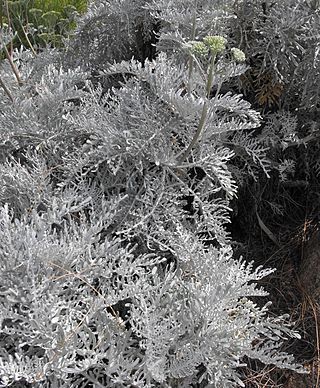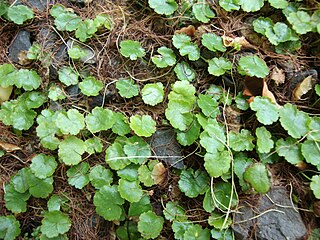
Symphyotrichum novae-angliae is a species of flowering plant in the aster family (Asteraceae) native to central and eastern North America. Commonly known as New England aster, hairy Michaelmas-daisy, or Michaelmas daisy, it is a perennial, herbaceous plant usually between 30 and 120 centimeters tall and 60 to 90 cm wide.

Lycium barbarum is a shrub native to China, with present-day range across Asia and southeast Europe. It is one of two species of boxthorn in the family Solanaceae from which the goji berry or wolfberry is harvested, the other being Lycium chinense.

Hesperevax sparsiflora is a species of flowering plant in the family Asteraceae known by the common name erect dwarf cudweed. It is native to California and Oregon, where it grows in several habitat types including sandy coastal areas and the serpentine soils of inland hills. This is a small woolly annual herb reaching maximum heights under 18 centimeters. It has oval to rounded or scoop-shaped leaves on short petioles which vary in morphology across varieties. Small flower heads appear between the leaves. They contain greenish or whitish disc florets.These florets are remarkably small, each being only 1/120th of an inch in width, and numbering 5 to 9 in the whole disc, which totals only 1/ 6th inch in width including bracts. This is the world's smallest composite inflorescence.

Brickellia californica, known by the common name California brickellbush, is a species of flowering plant in the family Asteraceae.

Constancea is a monotypic genus of flowering plants in the family Asteraceae containing the single species Constancea nevinii, which is known by the common name Nevin's woolly sunflower. It is endemic to three of the Channel Islands of California, where it grows in coastal scrub habitat. This is a small shrub or subshrub generally growing up to one or 1.5 meters tall, and taller when an erect form, with a branching, woolly stem. The whitish, woolly oval leaves may be up to 20 centimeters long and are divided into many narrow lobes with edges curled under. The inflorescence is a cluster of 10 to 50 or more small flower heads, each on a short peduncle. The flower head has a center of hairy, glandular, star-shaped yellow disc florets and a fringe of four to nine yellow ray florets, each about 2 millimeters long. The fruit is an achene a few millimeters long with a small pappus at the tip.
Hesperevax acaulis is a species of flowering plant in the family Asteraceae known by the common name stemless dwarf cudweed. It is native to California and Oregon where it grows in many types of mountain, valley, and coastal habitats, including areas recently affected by wildfire. This petite woolly annual forms a small bunch on the ground. Despite its common name it sometimes has a stem a few centimeters long. The wool-coated leaves appear in pairs or clusters, each leaf measuring a few millimeters to three centimeters long. In the center of the leaf array is the inflorescence, which is a single flower head or tightly packed cluster of several heads, each just a few millimeters wide. The flower head contains several tiny disc florets.
Harmonia nutans is a species of flowering plant in the family Asteraceae known by the common name nodding madia.
Microseris bigelovii is a species of flowering plant in the family Asteraceae known by the common name coastal silverpuffs. It is native to the west coast of North America, where its range extends from the southern tip of Vancouver Island to the northern coast of California.
Microseris elegans is a species of flowering plant in the family Asteraceae known by the common name elegant silverpuffs. It is native to California and Baja California, where it grows in the valleys, foothills, and coastal mountain ranges. Its habitat includes grassland, sometimes near vernal pools, and especially clay soils.

Acalypha indica is an herbaceous annual that has catkin-like inflorescences with cup-shaped involucres surrounding the minute flowers. It is mainly known for its root being attractive to domestic cats, and for its various medicinal uses. It occurs throughout the Tropics.

Nothocalais troximoides is a species of flowering plant in the family Asteraceae known by the common name sagebrush false dandelion. It is native to western North America, including British Columbia and the northwestern United States.

Pluchea odorata is a species of flowering plant in the aster family, Asteraceae. Common names include sweetscent, saltmarsh fleabane and shrubby camphorweed.
Stephanomeria elata is a species of flowering plant in the family Asteraceae known by the common names Santa Barbara wirelettuce and Nuttall's wirelettuce. It is native to Oregon and California, where it grows in coastal and inland mountain ranges, including the Sierra Nevada. It can be found in many types of habitat. It is an annual herb producing a slender, erect stem often exceeding one meter in maximum height. It is hairy to hairless and often glandular. The leaves are mostly located in a basal rosette, the largest reaching 10 centimeters long. Smaller, much-reduced leaves occur farther up the stem. The leaves drop early, leaving the plant naked for most of the year. Flowers occur singly or in small clusters along the stiff branches. Each head contains up to 15 or 16 ray florets, each with an elongated tube and a pink ligule 6 or 7 millimeters long. The fruit is an achene tipped with a spreading cluster of long, plumelike pappus bristles.

Deinandra conjugens is a rare species of flowering plant in the family Asteraceae known by the common names Otay tarplant and Otay tarweed. It is native to a small section of far northern Baja California in Mexico, its range extending north into San Diego County, California, in the United States. One isolated population has been reported from the hills east of Cayucos in San Luis Obispo County.

Clerodendrum infortunatum, known as bhat or hill glory bower, is a perennial shrub belonging to the family Lamiaceae, also sometimes classified under Verbenaceae. It is the type species among ~150 species of Clerodendrum. It is one of the most well-known natural health remedies in traditional practices and siddha medicine.
Chrysothamnus molestus is a species of flowering plant in the family Asteraceae known by the common names Arizona rabbitbrush, Tusayan rabbitbrush, disturbed rabbitbrush, and stickyfruit low rabbitbrush. It is endemic to the State of Arizona in the southwestern United States, where it is known from Coconino, Apache, and Navajo Counties.
Hazardia orcuttii is a rare North American species of flowering plant in the family Asteraceae known by the common names Orcutt's bristleweed and Orcutt's goldenbush. It is native to California in the United States and Baja California in Mexico. It can be found in one location in California, in the city of Encinitas. There, it is located in and near a protected zone known as the Manchester Conservation Area. In Baja California it can be found at 11 to 17 locations.

Borrichia frutescens is a North American species of flowering plants in the family Asteraceae known by the common names sea oxeye, sea oxeye daisy, bushy seaside tansy, and sea-marigold. In Veracruz it is called verdolaga de mar. It is native to the United States and Mexico, where it occurs along the Atlantic and Gulf Coasts. Its distribution extends from Maryland south to Florida and west to Texas in the US, and along the Mexican Gulf Coast to the Yucatán Peninsula. It is an introduced species in some areas, such as Bermuda and Spain.

Hydrocotyle sibthorpioides is a small plant native to southeastern Asia. It is also referred to as lawn marshpennywort. It is a dicot, traditionally placed in the family Apiaceae, but more recently suggested to belong in the Araliaceae. It grows in abundance when the conditions are right. Hydrocotyle sibthorpioides originated in southeastern Asia, but is slowly spreading in the United States, along with other places around the world. It can grow in a wide variety of habitats. It has been used for medicinal purposes in Asia and is also common in the aquarium trade.

Symphyotrichum racemosum is a species of flowering plant native to parts of the United States and introduced in Canada. It is known as smooth white oldfield aster and small white aster. It is a perennial, herbaceous plant in the family Asteraceae. It is a late-summer and fall blooming flower.













